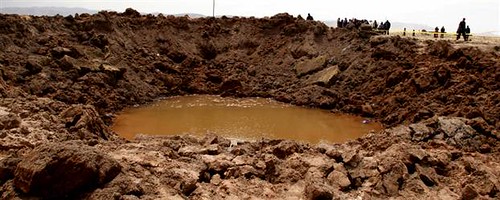Germs from Space!

You may have heard about the meteorite that recently fell near Puno, Peru (the impact crater is pictured above), and about the rash of illnesses that have occurred among locals following the crash:
According to Peru’s La Republica newspaper, due to the high number of illnesses, district authorities are considering placing the town of Carancas, Puno, Peru in a state of emergency. It has been reported that at least 600 people have been affected by the meteorite.
Puno, Peru’s Regional Health Director, Jorge López Tejada, reported yesterday that at least 150 people had been seen after having stated they had dermal injuries, were dizzy, nauseous or vomiting.
According to the townspeople, the illnesses began after the meteorite crashed and they began to touch the glowing rock believing it had some type of monetary value. Aside from the hundreds of townspeople that were affected, Tejada reported that 8 police officers had to be hospitalized after having taken samples of the meteorite.
Scientists have confirmed that the meteorite is a chondrite meteorite, meaning it likely originated in the asteroids that orbit the Sun between Jupiter and Mars.
The stories out of Peru along with a story out of the Toronto Globe and Mail have us thinking about the Andromeda Strain.
First, the Globe and Mail:
Bacteria that cause food poisoning on Earth get stronger in space, says a team of researchers that sent dozens of carefully packaged vials of salmonella on a 2006 shuttle mission.
After 12 days in orbit, the shuttle bugs were nearly three times more deadly to mice.
The researchers, who are reporting their findings this week in the Proceedings of the National Academy of Sciences, were able to zero in on the protein that caused the increased virulence. They say their work may one day lead to a vaccine to protect against Salmonella typhimurium, or a new antibiotic to keep an infection in check – both in space and on Earth.
Next, the Andromeda Strain. You remember this, don’t you? It’s the story of a U.S. Army satellite that returns to Earth and lands in the small town of Piedmont, New Mexico. The satellite "brings a mutant living being and all the population, except a crying baby and an old man with ulcer, dies with clotted blood. A team of five scientists are summoned and gathered together in the top secret Wildfire facility" to identify the virus before it’s too late.

Well, that’s not what’s happening in Peru. So what is? Here’s one theory:
"The meteor that crashed in Peru caused a mystery illnesses. The cause of the illness has been found. The meteor was not toxic. The ground water it contacted contains arsenic. The resulting steam cloud is what caused the mystery illness. "The meteorite created the gases when the object’s hot surface met an underground water supply tainted with arsenic, the scientists said." There is a very good photo of the impact crater in the article. The rim of the crater is lined with people for a size comparison."
We’ll undoubtedly learn more about the source of the illnesses in Peru (check out this comprehensive analysis of the various theories). But for now, we want to share a bit of local advice that we kept close to heart during our years living on the Colorado Plateau, where uranium is found in abundance: Don’t touch glowing rocks. Nothing good ever comes of it.
